
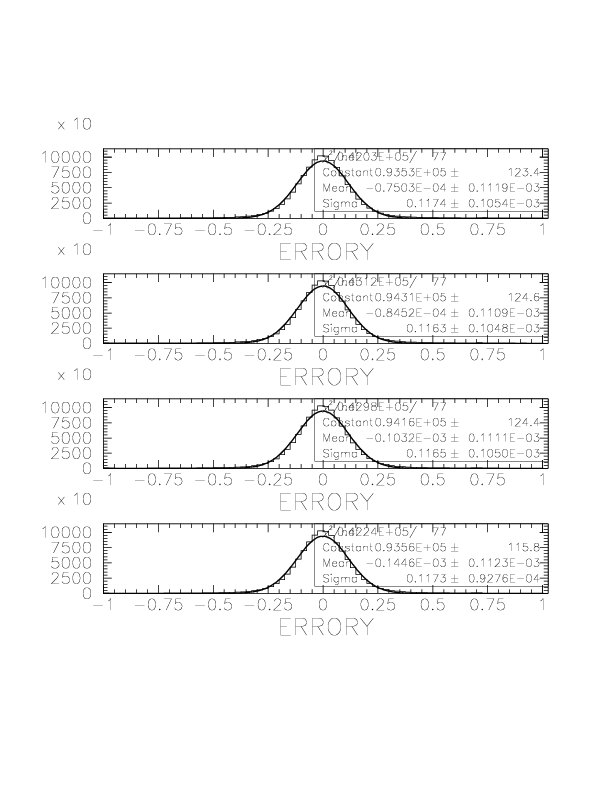
BLC analysis - investigation of plane relative shift and dt-dx reconstruction
After reliable local dt-dx function construction, relative shifts of planes are studied as follows:
1: Perform fitting if all 8 planes are available.
2: Deduce the mean value (by simple Gaussian fit) of the residual distribution on each plane. The residual distributions with nominal plane position for each plane is seen here .
3: Resulting 8 mean values are used to determine relative shifts. We note that if we select two planes as the standard, the plane shifts of all other 6 planes can be exactly determined from the 8 residual information.
4: Since we do not know which conbination is the most reliable(i.e the smallest deviation of the slope of the standard line from the equi-potential line of the inner electric field), All 8C2=28 conbinations are examined, and the conbination gives the best resolution (gaussian sigma for residual distribution to which results from all 8 planes are combined) is elected.
| X resolution(mm) | Y resolution(mm) | Plane combination | Comment |
|---|---|---|---|
| 0.1319 | 0.1213 | 0-1 | |
| 0.1612 | 0.1491 | 0-2 | |
| 0.2416 | 0.1206 | 0-3 | |
| 0.1760 | 0.1235 | 0-4 | |
| 0.1613 | 0.1559 | 0-5 | |
| 0.2550 | 0.5256 | 0-6 | |
| 0.1284 | 0.4154 | 0-7 | <- adopted in E549 as the x referencial |
| 0.1518 | 0.1408 | 1-2 | |
| 0.2284 | 0.1192 | 1-3 | |
| 0.1789 | 0.1219 | 1-4 | |
| 0.1548 | 0.1525 | 1-5 | |
| 0.2439 | 0.4831 | 1-6 | |
| 0.1286 | 0.3933 | 1-7 | |
| 0.1687 | 0.1166 | 2-3 | <- adopted in E549 as the y referencial |
| 0.1775 | 0.1184 | 2-4 | |
| 0.1404 | 0.1361 | 2-5 | |
| 0.2188 | 0.3984 | 2-6 | |
| 0.1295 | 0.3035 | 2-7 | |
| 0.1682 | 0.1177 | 3-4 | <- y referencial combination in E471 |
| 0.1376 | 0.1306 | 3-5 | |
| 0.2117 | 0.3949 | 3-6 | |
| 0.1298 | 0.2970 | 3-7 | |
| 0.1368 | 0.1201 | 4-5 | |
| 0.1887 | 0.3457 | 4-6 | |
| 0.1307 | 0.2294 | 4-7 | |
| 0.1775 | 0.2817 | 5-6 | |
| 0.1311 | 0.2123 | 5-7 | <- x referencial combination in E471 |
| 0.1321 | 0.1858 | 6-7 |


As seen, the best resolution is realized for N=3 and 2 for x and y, respectively (same as those in E471), and those values are adopted. The resulting shift is given in the next table:
| X shift(mm) | Y shift(mm) | |
|---|---|---|
| 1 | 0.0 | -0.3748 |
| 1-dash | 0.1171 | -0.1920 |
| 2 | 0.1255 | 0.0 |
| 2-dash | 0.1899 | 0.0 |
| 3 | -0.1638 | 0.2147 |
| 3-dash | 0.0252 | 0.2547 |
| 4 | -0.3106 | 0.1690 |
| 4-dash | 0.0 | 0.9017 |
Since we have obtained the relative shifts of BLC planes, we study the BLC resolution through all production term, and study whether dt-dx reconstruction is required, or not.
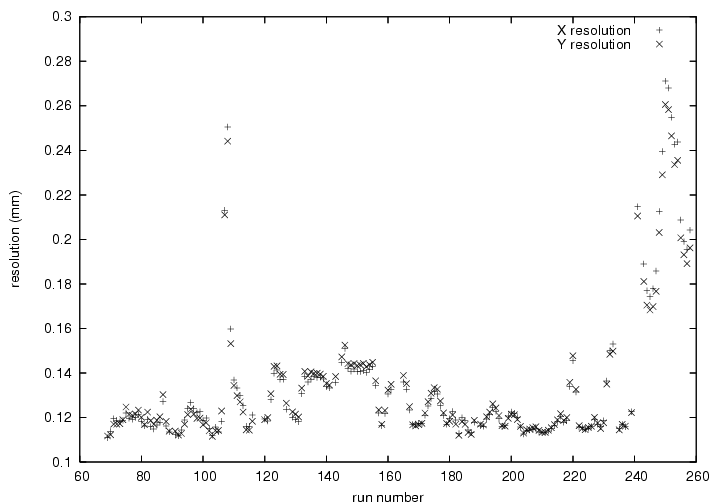
As seen, the resolution is NOT STABLE, especially after run 240. We do need time-to-time dtdx construction again.
Result of time-to-time dtdx-reconstruction. Partly improved, but partly aggravated....
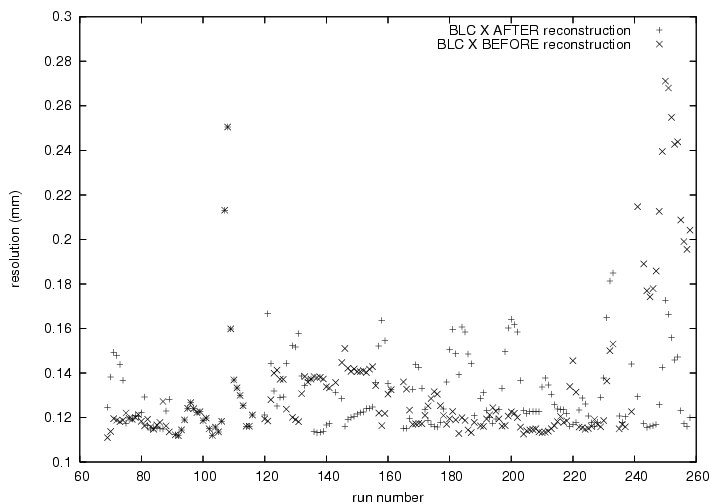
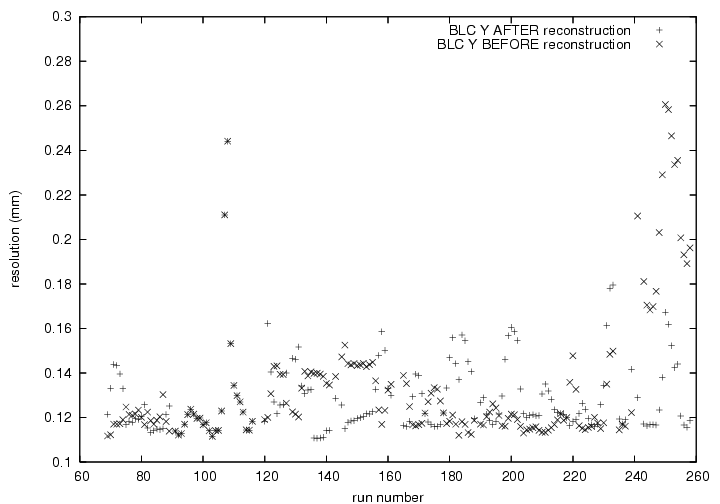
The original dt-dx function is kept, and reconstructed ones are used to the runs for which the resolution is improved with reconstructed dt-dx function. Note that the resolution is surely improved AFTER run 240.
| run | dt-dx(dy) reeference |
|---|---|
| 69-81 | 91-116 sum |
| 82-87 | 69-90 sum |
| 88-122 | 91-116 sum |
| 123-126 | 117-141 sum |
| 127-132 | 91-116 sum |
| 133-142 | 117-141 sum |
| 143-156 | 142-162 sum |
| 157-171 | 91-116 sum |
| 172-178 | 163-188 sum |
| 179-240 | 91-116 sum |
| 241-258 | 241-258 sum |
When this table is naively applied, resulting resolution long-term variation is as below.
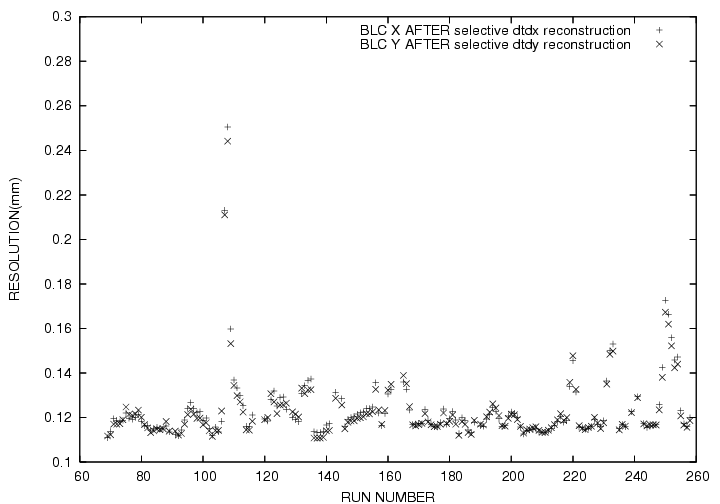
Now, BLC resolution is fairly stable at around 120 micron, while 107-109, 219-221, 231-233, 248-255 still need special care. Note that these jumps are not likely to be generated by some broken channels on chamber side including all read-out electronics, since x and y variation is perfectly synchronizing. It may be hardware trigger problem which might be caused by some problems on H.V. supply.
We leave the BLC local tracking problem, noting that special care to those production runs giving sudden jump of the resolution are required for the final spectrum construction.
To be done on tracking (in order) ....
0. BLC tracking - globally completed through the production term. Now, waiting for completion of other parts for the relative position study.
1. VDC tracking: Time-to-time spline correction. Intensive study is required - see, 0811 . The correction is required BEFORE getting VDCbottom rotation and relative shift - by cosmic ray.
2. PDC tracking: Under construction. Shift correction, time-to-time dt-dx reconstruction are not done yet - they are done by completely identical procedures to those for BLC. The combination number is 4C2 =6 for each, hence the procedures will be even easier than those done for BLC. PA retiming would be needed for delayed events AFTER PA relative timing is adjusted, but it cannot be done at this stage.